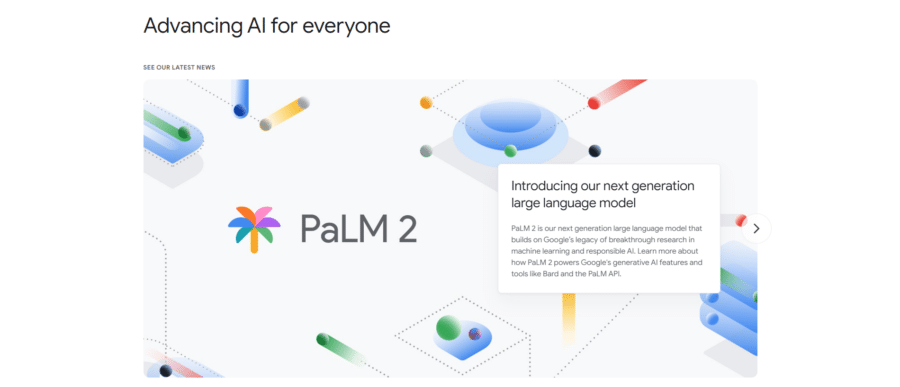Slowly but surely, artificial intelligence (AI) has risen to become one of the most creative technology assets in the past decade. If you’ve used an AI tool, you already know what all the hype is about.
If you’re a fan of Google’s innovative technology, you know that artificial intelligence has been vital in shaping its features and assets since 1998, when it was only a brand-new platform and not the gigantic business that it is today.
In the beginning, AI’s primary function was to improve Google’s ability to interpret and understand capacities and aptitudes. Nowadays, AI has become one of the leading fields in computer science, with Google being the leading tech company that has developed various branches for their AI apps and features.
The Google AI development branch has created various apps and AI-powered technologies that are integrated into several of its subsidiary platforms, including:
- Gmail
- Google Ads
- YouTube
- Google Search
- Google Cloud
- Pixel
- Google Assistant
- Google Photos
- Google Maps
Want to know more about it?
In this article, I’ll introduce you to Google AI and how it impacts YouTube, Google Search, and Google Ads, so you can get a clear picture of what these platforms are all about and how Google uses AI to improve their functionality and user experience.
Let’s start with a brief overview of Google AI’s key features.
Table of Contents
What is Google AI?
Google AI is the development and research sector for Google’s AI-powered tools and assets. Its primary focus is AI development, deep learning, natural language processing, machine learning, computer vision, and robotics. The platform collaborates with many industry leaders and shares several open-source projects worldwide, such as TensorFlow, BERT, MediaPipe, and others.

Google AI has become a leading technology asset with the help of Transformer: a neural network that helps in the language understanding process developed in 2017 by Google.
Many people call it the “grandparent” of today’s NLP models that helped researchers create today’s AI language models, such as MUM, BERT, LaMDA, and PALM.
These powerful language models can solve various sorts of complex issues connected to AI language learning capabilities and text classification, give relevant answers to questions in different languages, and more, all the while employing a chain of thought.
Google upgrades and adjusts its AI technology by using ML algorithms that help it recognize predictions and patterns to create unique content. It pulls information from various user interactions through its platforms like Photos, Maps, and the leading search engine, which is used by more than 4 billion people from all parts of the world!
Once Google gathers relevant data, it goes through a cleaning process and prepares it for further analysis with the help of ML algorithms. Google collects data in very large quantities from all kinds of sources, such as website visits and interactions among visitors.
Before the analysis procedure, Google cleans all the data errors or inaccuracies. During the analysis procedure, Google extracts relevant information from the gathered data. With the help of statistical techniques, the algorithms can predict specific data insights and patterns.
While doing so, Google uses the results from the data analysis to also improve and develop the algorithms, ultimately enhancing their precision and reliability. Each time Google goes through the data analysis process, it modifies and improves its algorithms at the same time.
What Does Google AI Stand For?
Google AI stands for Google’s artificial intelligence development and research sector. It was previously called Google Research, but it was rebranded in 2018. This sector mainly focuses on AI research tasks and projects and aims to develop AI technology.
So far, Google has created many AI-powered tools, such as Google Docs, Assistant, Maps, Translate, Search, and more. These tools were developed in Google’s sector focusing on AI development and research, and are continuously being improved.
Where and How is Google AI Available?
Google AI is available through several platforms created by Google. Here are popular AI-powered Google platforms used by individuals worldwide:
- Google Maps
- Google Cloud
- Google Photos
- Google Assistant
- Google Translate
- Google Search
Google AI in YouTube Ads
Google AI has been super beneficial for video ads on YouTube. With its help, you can create vertical, horizontal, and square ads, and use additional assets from various sources you already have created, such as your product feed, ad campaigns, app listings, etc.

You can add your creative ads to a YouTube video and even implement voice-overs since Google uses technology that converts text to speech and vice versa. By adding generated video captions, Google AI makes YouTube videos easily accessible to people with hearing difficulties.
Even though every person has their viewing habit, with the help of Google AI, you can reach viewers on various platforms and screens and help users communicate with each other much easier than before.
With video campaigns created with the help of AI, you’ll get to advertise your business in various online environments. For example, you can advertise on in-feed, in-stream, and YouTube Shorts platforms and place your ads on devices like mobile, desktop, and TV.
If you want to optimize your website to improve your conversion rates and increase your site traffic or drive more awareness, try using Video action campaigns.
Google also announced that they’d make in-feed ads available and that Shorts is expanding into Video reach campaigns, so ecommerce business owners can reach new audiences and place their ads more often on YouTube.
Google AI in Google Ads
Google AI has been a foundational feature of Google Ads since the beginning. With the help of Google AI, merchants can optimize their ads, which ultimately helps their businesses grow, expand, and get more conversion rates.
With the help of modern AI, Google Ads can analyze and monitor ads and landing pages and generate all kinds of headlines, images, keywords, and other assets that can help business owners personalize their ad campaigns on Google.
Google AI is used for various subcategories of ad campaigns, such as the Performance Max campaign. Merchants can optimize their Performance Max campaign, which will help them improve their ad effectiveness according to their conversion goals. Performance Max optimizes ad campaigns’ efficacy across Google’s platforms, such as YouTube.
There are several Google Ads AI-driven features, such as Responsive Search Ads, Smart Bidding, and Dynamic Search Ads. Here are their essential features:
Responsive Search Ads
Responsive Search Ads are AI-driven ad formats that analyze various ad elements and find the most suitable elements for your personalized ad. With their help, you can easily create fully-customized and flexible ads to target specific customer groups. It’s a pretty simple format, so you’ll learn how to use it quickly.
All you have to do is enter a few descriptions and ad headlines. Then, Google Ads will test combinations with your entered data and find the best-performing ones.
Responsive Search Ads consider performance metrics and data like conversion and click-through rates to generate the best combination. With its help, you can tailor all of your product descriptions and headlines to meet the needs and wants of your customers, depending on their specific location, age group, gender, etc.
Smart Bidding
Google’s bid strategies, also known as Smart Bidding, use the benefits of Google AI whenever it’s necessary to optimize and improve conversions. They can also enhance conversion values in different auctions, which is why this feature is also called auction time bidding.
There are four bidding strategies of this type:
These bidding strategies help advertisers set specific performance goals and customize their ads’ features to meet their business expectations.
Here’s what these strategies offer:
- A specific attribution model where you can optimize the search bids;
- Establish performance targets and objectives for different devices (tablet, desktop, and smartphone) with the novel bidding known as Target CPA that Google will launch in the near future;
- Use the benefits of integrated features to maintain AI-powered bidding strategies in one place.
Dynamic Search Ads
Google launched Dynamic Search Ads in 2011, and 12 years later, they remain the most accessible and straightforward ad format. With the help of AI technology, these ads help merchants discover brand-new customers by browsing the web for specific customer characteristics and using automatic targeting.
They’re perfect for advertisers and merchants with a fully-developed ecommerce website with a wide-ranging selection of products.
Dynamic Search Ads use the content available on the website and keep ads up-to-date. They’re pretty simple to use, and all you have to do to launch your Dynamic Search Ads is write a creative and unique description.
Google AI in Google Search
Google Search is a complex system created with the help of two learning algorithms: AI and neural networks. It’s powered by various AI search algorithms, such as RankBrain, BERT, Multitask Unified Model (MUM), and neural matching.
Although the system is pretty elaborate, using Google Search is quite simple. Anyone can use it by opening any browser, typing google.com, entering a word in the search field, and clicking the little search button.
These algorithms process enormous quantities of search queries and data and constantly update the search algorithm in real time, so Google users can always get the latest information whenever they use Google Search.
Some of the most powerful AI-powered features in Google Search are:
- Featured snippets
Google uses boxes called Featured snippets to reverse the search results format. By using them, Google shows the descriptive boxes first. The snippets appear in the “People Also Ask” category on Google Search, too.
You’ll be automatically redirected to another page section when you click on one of the snippets. However, if the browser you’re using is an older version and lacks the technology to redirect you to another web page, once you click on a featured snippet, you’ll be redirected to the top of the source web page.
- Knowledge panels
Google Search contains automatically generated information boxes known as Knowledge panels. The structured data in the Knowledge panels usually comes from Google’s Knowledge Graph.
They appear when searching for different entities, such as places, people, organizations, locations, etc. Knowledge panels’ main task is to provide a brief overview of the topic you’re looking for. These information boxes are regularly updated by Google, just as online information changes.
- Google Discover

Unlike Google Search, Google Discover is a personalized and unique search feed that finds online content based on the automated systems used by Google.
Google tunes this AI-powered asset to match the user’s interests so the content that appears after a search query aligns with the user’s profile. The content can be in various formats, such as videos, images, and articles. Since it’s filtered content, it usually doesn’t contain petitions, satirical articles or images, job applications, or code repositories.
All of the content that appears in Google Discover has to match Google’s policies and guidelines, otherwise it won’t appear in Google’s Search Console.
User Intent, Semantic Search, and Voice Search Optimization
AI is essential in understanding user intent, semantic search, and voice search optimization. The latest AI technology has the power to provide highly relevant search results for users worldwide, make the search process much more intuitive, and tailor it to the specific needs of each user.
One of the most critical discoveries in user intent is RankBrain, an algorithmic system that Google launched in 2015. RankBrain’s primary goal is to comprehend user intent and find out why users are searching specific niches on Google.
In addition to user intent, AI has an essential role in semantic search, a specific search process that engines use whenever they need to generate correct and precise SERP findings.
The results are generated after the engine automatically analyzes the context of a user’s query, their intent, and, last but not least, the intricate and complex link between different words.
This type of search has started to advance significantly after the development of voice search.
Today, smartphone voice search commands are frequently used by people from all around the world. About 33% of people who live in wealthy households use voice search commands. Voice search is possible with the help of automatic speech recognition (ASR), also known as text-to-speech, an essential feature of voice AI.
With the help of ASR, you can use voice search since your computer, laptop, or smartphone can concisely understand your voice query and transcribe your questions.
How Does Google AI Impact Google’s Position in AI Technology?
Google AI significantly impacts education, career development, natural sciences, climate change research, and other important fields.
Regarding education and career development, back in 2018, Google gave a financial grant to Quill.org, an AI-powered platform created for students. This platform helps students improve their writing skills with the help of modern AI technology.
Has Google AI Achieved Sentience?
So far, Google AI hasn’t achieved sentience. The AI technology created by Google doesn’t have consciousness or self-awareness and cannot feel emotions like human beings.
It operates entirely using complex structured data and predefined algorithms, but it’s 100% artificial intelligence technology that doesn’t feel human emotions and is not aware of its existence (at least not yet).
Recap
Google’s AI-powered tools and assets have, without a doubt, completely changed how we live our lives. They’re helpful and practical and have the power to improve the quality of people’s lives throughout the entire world.
Google’s AI-powered platforms help business owners get a better sense of the essential characteristics of their users, personalize their ads, and improve their websites’ user experience to suit their target audience’s wants and needs.
